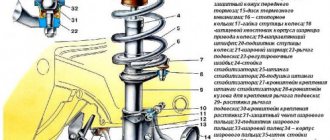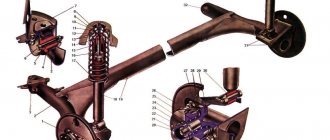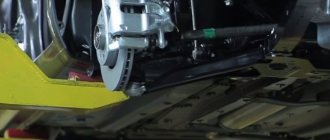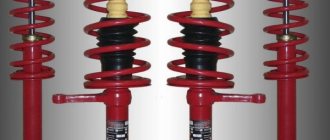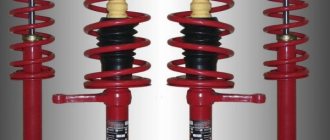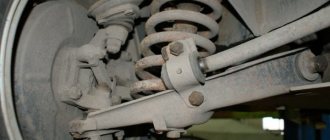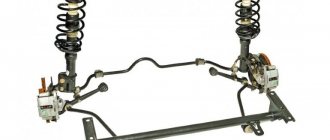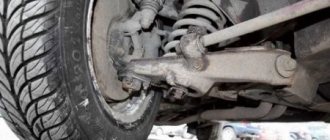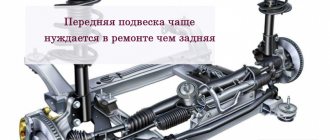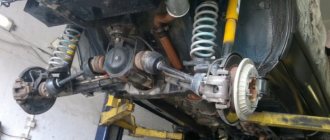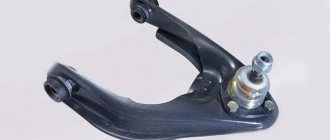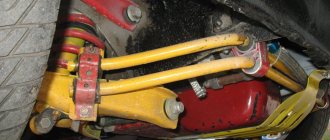The first photo shows the chassis of the VAZ 21099, typical of front-wheel drive cars produced in the 80s of the last century. Below you will find an image of a MacPherson front suspension with telescopic struts and wishbones with braces and a stabilizer. The rear suspension of the VAZ Sputnik has shock absorbers located inside coil springs and trailing arms connected to each other by an elastic beam.
Repairing the chassis of a VAZ 21099 car with your own hands is not very difficult. The main thing is to have the necessary tools and be able to correctly identify faults.
Front suspension diagram of the VAZ Sputnik-Samara.
- Telescopic stand.
- Screw.
- Bolt with eccentric.
- Another nut.
- Rounded fist.
- Drive shaft.
- External CV joint cover.
- External CV joint.
- Cross arm suspension.
- Ball.
- Decorative cover.
- Hub.
- Support disk.
- Protective cover.
- Swivel lever.
- Lower spring cup.
- Coil spring.
- Rack cover.
- Compression buffer.
- Upper spring cup.
- Upper strut bearing.
- Rack support.
This diagram does not show the braces and front stabilizer.
Visual fault diagnosis
Among the methods for identifying faults, the visual method is good because it allows you to identify minor damage to parts long before they lead to a serious breakdown. In this case, emergency repairs to the front suspension will not be required, and most importantly, there will be no risk of creating an emergency situation.
It is better to inspect the chassis parts of the VAZ 21099 on a clear sunny day. If this is not possible, you should prepare a powerful flashlight. In addition, it is necessary to have a rag and a brush with soft bristles in advance to wipe off dust and dirt from the surfaces being inspected.
- First, drive the car onto a lift or pit. If this is not possible, raise the front of the car with a jack. Don't forget to put the car on the handbrake and support the rear wheels.
- For convenience, remove the front wheels.
- Carefully inspect the protective covers of constant velocity joints, ball joints, as well as stabilizer pads and silent blocks. If ruptures, cracks or one-sided bulging of rubber are detected, replace the damaged parts.
- Inspect metal parts for cracks and bends. If problems are found, supply new spare parts.
- Check for oil leaks on the struts. If there are any, replace the shock absorbers or entire struts.
- Inspect the compression buffer and spring for cracks. Replace them if necessary.
- Measure the distance A (in the above diagram) between the support plate and the front suspension arm. If, when rocking the travel distance, the distance increases by 0.8 millimeters or more, replace the ball joint.
- Rock the hub left and right and up and down. If it sways and a knock is heard, the car needs to be repaired and the wheel bearing will have to be replaced.
Replacing suspension silent blocks
If no damage is found, don't feel like you wasted your time. Such an inspection must be carried out every 5,000 kilometers. It will help you avoid serious problems while driving.
If you don’t want to waste time, do a little tuning - install a front stabilizer from a Lada Priora during diagnostics. It is perfect for the VAZ 21099. With it, the chassis of your car will become more rigid, but the car’s stability at high speeds will improve.
To learn how to independently repair or carry out preventative measures on a car, the first thing a car owner should do is study its design. Today we’ll talk about the front suspension of the domestic car VAZ 2109.
Replacing shock absorbers
If you first press the rear of the VAZ car and then release it sharply, the trunk should return to its original position without any hesitation. Long swinging of the trunk will indicate a malfunction of the rear shock absorbers. Since the factory devices are of a non-separable design, they should be replaced with new shock absorbers. Here's what it takes.
| Action | Result |
| First, the Lada VAZ is put in first gear, then the rear wheels are removed. | Thanks to this, niches are freed up. |
| The side trims are removed. | This must be done to get to the upper mounting of the rods, |
| After this, the fixing nuts are unscrewed from the upper and lower bolts. | To make it easier to remove the shock absorber, its rod should be pushed down all the way. |
| The device is removed along with the spring, compression buffer and cushions. | Installing a new shock absorber is performed in reverse order. |
| By the way, pillows are available in different thicknesses. If you want to raise the rear of the 2109, larger parts must be installed. | At this point, the repair of the rear shock absorbers can be considered complete. |
If the rubber-metal suspension bushings have lost their elasticity, in this case it is necessary to replace the lever. To do this, you need to turn on the handbrake and support the rear wheels with special stops. Then the front part of the car should be raised with a jack and secured. After this, the pressure nut of the ball assembly is unscrewed.
Using a removable device, the finger is removed. Next, the brace fastening is released and the stand is disconnected. The bolt with which the lever is attached to the body bracket is also released. After this, the old part is removed and a new lever is installed in its place.
The anti-roll bar is changed in a similar way. Both racks are unscrewed from both sides of the car. The stabilizer bar is then detached from the brackets. When installing a new rod, do not overdo it when tightening the nuts. They should be tightened until the gap in the cushions disappears.
The final tightening of all nuts is carried out with full load on the suspension, when the machine is on the ground.
How the front suspension of the VAZ-2109 works
It is very important to do timely maintenance of the vehicle’s chassis, since the main load during operation falls on it. Moreover, the load also occurs at rest. The chassis includes the following elements: frame, wheels, rear and front suspension. Early diagnosis will help avoid many problems.
What is the front suspension? This element of the car is independent, which allows the car to be more maneuverable, since the front wheels work independently of each other. If one of them hits a pothole, the other avoids this impulse. Such design features allow you to adjust the wheel alignment of the car; you can also correct the “behavior” of the car on the road using a small negative value for the rolling radius.
The main part of the front suspension is the shock absorber struts, the springs are attached to them. There are 3 bolts and a bearing attached to the top of the rack. All this as a whole provides the ability to rotate the stand with the wheels of the machine.
The next main part is the rotary cam. Its lower part is attached to the ball joint, and its upper part is connected to the bottom of the rack. The connection is provided by bolts. The upper one adjusts the camber. The lateral stability of the car is ensured by a rod, which is secured by silent blocks to the base of the car using brackets.
Thus, we see that the front suspension includes a lot of parts, but the most basic of them are:
Other causes of malfunctions and possible repairs
Replacing the front suspension or repairing it may be necessary due to the following conditions:
- If there is a large difference in tire pressure, this indicator needs to be adjusted.
- Violation of wheel mounting angles - timely adjustment of this unit is required.
- Deformation of the rubber element of the support strut - can be solved by replacing the faulty part.
- If there is a large difference in the elasticity of tires or spring mechanisms, the defective spare part should be replaced.
- In addition, it is necessary to monitor the balancing of the wheels.
To avoid premature repair of the front suspension, it is necessary to follow the recommendations for the maximum load of the vehicle, avoid sudden acceleration and not exceed the maximum permissible values specified in the operating instructions.
What problems can there be and how to fix them
The condition of the front suspension should be monitored regularly. The most common damage is abrasion of the joint covers. These damages are classified as mechanical. Among the malfunctions of this element of the car, unevenness of the lever located on the suspension or on the stabilizer bar is noted. This may result in incorrect and inaccurate operation. In all these cases, you need to check the parts and then simply replace them with new ones.
Among the malfunctions there may be minor ones that should be eliminated using a regular repair kit. For example, loosening the bolts of the stabilizer bar or the nut of the support. You should tighten them tighter.
If you hear the suspension making sounds (knocking, creaking), then this indicates more serious damage. First you need to determine where the sound is coming from. You can use a jack for this. Rock the wheel in a vertical plane; if there is a knock in the center of the wheel, then most likely there is a fairly large gap in the bearing. It is better not to change the bearing yourself, as it can be destroyed. It is better to contact a car service center that has special equipment for these purposes.
We draw conclusions: it is better to diagnose and prevent your car and protect yourself while driving than to invest in tuning.
Insufficient strut resistance
If the front suspension of the VAZ-2109 has lost the tightness of the return or bypass valve, it is necessary to replace the damaged parts. If there is a small amount or leakage of the working mixture, it is necessary to check, replace worn parts, and add the used composition to the norm.
In addition, in case of wear, settlement, deformation of the guide bushing, rings of the cylinder-piston group, spring mechanism, unusable elements and filters should be replaced and new fluid should be added. It is also necessary to pay attention to the integrity of the additional spring elements, valve discs and hinge block. If necessary, deformed elements must be replaced as quickly as possible, which will facilitate the rapid restoration of the unit in question and prevent further damage.
VAZ 2109 front suspension diagram
The front suspension of the VAZ 2109 is an independent element of the car, which allows each wheel to work separately from the other. This moment is a very important emphasis in driving a car. Due to this, the VAZ 2109 handles better and feels the road, allowing you to perform complex maneuvers and elements of extreme driving.
The main element of the front suspension of the VAZ 2109 is a telescopic shock absorber strut. There are racks:
- Buttered ones are soft and comfortable. A good choice for bad roads. But on the highway you will be thrown around at high speed.
- Gas - rigid racks. A good choice for highways, highways and roads without holes and potholes. With such struts, the car holds the road well at high speeds.
- Gas-oil ones are something between the two previous racks. Usually these are the racks that are installed. as they are not too hard and soft.
The racks are equipped with coiled springs for rigidity, which also determines your comfort. The top of the strut is secured with 3 bolts along with a support bearing that allows the strut to turn with the car's wheels.
- Shock absorber strut.
- Rod bracket.
- Traction.
- Front lever.
- Spherical bearing.
- Rotary cam.
- Front stabilizer
- Stabilizer bar
The next most important mechanism in the front suspension is the steering cam. Its lower part is connected to a ball joint, which allows us to rotate our mechanism. The top of the steering cam is connected by two bolts to the bottom of the strut. The top bolt allows you to adjust the camber. A thrust bearing is attached to the rotary cam itself, on which the hub is in turn attached.
The anti-roll bar is a bar, which is attached to the car body through silent blocks using a bracket (popularly called crabs). and on the other side to the lower suspension arm.
Description of design
The front suspension is independent, with telescopic hydraulic shock absorbers, coil springs, lower wishbones with braces and a stabilizer bar.
The basis of the suspension is a telescopic hydraulic shock absorber strut. Its lower part is connected to the steering knuckle with two bolts. The top bolt that goes through the hole in the strut bracket has an eccentric collar and an eccentric washer. By turning this bolt, the camber of the front wheel is adjusted.
The telescopic strut is equipped with: a coil spring, a polyurethane foam compression stroke buffer, as well as an upper strut support assembly with a bearing.
The upper support is secured with three self-locking nuts to the body mudguard strut. Due to its elasticity, the support allows the rack to swing during suspension movements and dampens high-frequency vibrations. A bearing pressed into it allows the rack to turn along with the steered wheels.
Parts of a telescopic hydraulic shock absorber are mounted in the strut housing. If it fails, a repair cartridge can be installed in the rack housing.
The body of the VAZ-2108 rack is slightly longer than the VAZ-2110, so using an externally similar cartridge from the VAZ-2110 is impossible.
The lower part of the steering knuckle is connected to the lower suspension arm through a ball joint. The support is secured with two “blind” bolts. When unscrewing these bolts, be careful: with significant force they often break, so before disassembling, tap their heads in the axial direction.
Braking and traction forces are perceived by longitudinal braces connected through rubber-metal hinges to the lower arms and brackets. At the connection points (at both ends of the brace), adjusting washers are installed for the longitudinal inclination of the steering axis.
A double-row angular contact ball bearing of a closed type is secured in the steering knuckle with two retaining rings. The wheel hub is installed with tension in its inner rings. The bearing is tightened with a nut on the shank of the outer wheel drive joint housing and is not adjusted during operation. The wheel hub nuts are the same, with right-hand threads.
Anti-roll bar - spring steel rod. The ends of the stabilizer are connected to the lower suspension arms through struts with rubber-metal hinges. The middle part of the rod is attached to the body with brackets through rubber pads.
Front suspension of VAZ 2109 diagram.
- Upper suspension strut support.
- Top cup.
- Progress buffer.
- Buffer support.
- Coil spring.
- Lower spring support cup.
- Ball traction control.
- Rotary lever.
- Shock absorber strut.
- Washer.
- Adjustment bolt.
- Rack bracket.
- The cam is rotary.
- Protective casing.
- Brake disk.
- Retaining ring.
- Hub cap.
- Grenade.
- Guide pin.
- Wheel bearing.
- Ball bearing.
- Lever arm.
- Washers.
- Front stabilizer.
- Stabilizer bar.
- Stabilizer silent block.
- Internal rod bracket.
- Crab. (outer rod bracket)
- Lever stretch.
- Bracket for fastening the brace.
- Silent block of the lever hinge.
- Suspension spacer.
- Stock.
- The upper support housing is external.
- Internal upper support housing.
- Upper support bearing.
- Rubber element for upper support.
- Travel limiter.
- Protective cap.
- Extension joint bushing.
- Stretch joint cushion.
- Washers.
- Stabilizer link joint.
- Rear hinge.
- Ball joint housing.
- Ball bearing.
- Ball pin.
- Protective cover.
© 2022 Repair and tuning of domestic cars Joomla! is Free Software released under the GNU General Public License.
Unusual sounds when moving
If there are certain malfunctions, the front suspension of the VAZ-2109 may make noise or knock. Below are the main causes of problems and recommendations for resolving them.
- If the racks have become unusable, they need to be replaced or repaired.
- The fixing bolts of the stabilizer bar are loose. If the tension pads wear out, the bolts should be tightened and the worn pads replaced.
- Poor quality fastening of the upper support - the problem can be solved by tightening the fixing nuts.
- There is settlement and destruction of the supporting rubber element - it is advisable to replace the problematic part.
- If the lever silent blocks, braces or stabilizer rod struts are worn out, new blocks should be installed.
- The ball joint will need to be replaced if it becomes excessively worn.
- If there is a significant imbalance of the wheels, it is necessary to carry out balancing.
- If a spring or compression buffer breaks, it requires immediate replacement.
Front axle
The front axle has an independent telescopic suspension, which uses both hydraulic shock absorbers and coil springs. The wishbone is the lower one with braces. The chassis is equipped with a stabilizer bar. The suspension device of the VAZ 2109 is almost identical to that of the VAZ models 2108, 21099.
Components and parts of the front axle chassis
The front axle of the VAZ 2109 is perhaps the most complex element of the chassis, this is due to the fact that the car’s transmission is front-wheel drive, but the number of main components in its structure is not so large. This:
- Strut with shock absorbers;
- Rounded fist;
- Cross arm;
- Stretch marks;
- Mounting units for the chassis to the body and transmission;
Description of the front suspension design
The chassis of the front axle of the VAZ 2109 contains quite a lot of elements, but everything is typical for cars of this class and its design has something in common with many cars of the same type. The main part is a telescopic stand with a hydraulic shock absorber. A coil spring with a stroke buffer is installed on top of the hydraulic cylinder. The upper support is also made of polyurethane and ensures the rack swings and vibration damping. The device for fastening the rack to the body (with three bolts) allows you to dampen vibrations. There is also a ball bearing inside the support, which ensures that the stand rotates together with the wheel. At the bottom of the steering knuckle there is a ball joint for connection with the lower suspension arm.
To compensate for the forces, there are stretchers with rubber-metal hinges. To install the wheel hub, a double-row thrust bearing is mounted in the steering knuckle. The hub is secured with one bolt. The suspension device also includes a stabilizer; it is connected to the lower suspension arms through struts with rubber hinges.
Replacing rubber joints on the rear suspension
More on how things are changing. First, let's look at how to replace the rear silent blocks of a VAZ-2109. To perform the operation you will need:
- Inspection hole;
- Jacks;
- Tools (key sets, hammer, attachments);
- Bench vice;
- Mount;
- Spring ties;
- Soap solution;
- Pullers for rubber joints;
First, the silent blocks of the rear beam of the VAZ-2109 are replaced. For this:
- We put the car in a pit, jack up the rear on one side, remove the wheel;
- Unscrew the nut of the bolt securing the beam to the body, remove the bolt;
- Using a pry bar, we press the beam down to remove it from the bracket, fix it in this position (by installing a wooden spacer between the beam and the body);
- Using a hammer, carefully knock out the worn hinge;
- Using a device (a long bolt with a nut, two wide washers and a piece of pipe), we press in a new element, having previously generously lubricated the seat and the hinge itself with soapy water;
- We install the beam into the bracket and fix it with a fastening bolt;
After this, the silent blocks of the VAZ-2109 rear pillar are replaced:
- Unscrew the fastening of the rack to the body (top) and beam (bottom);
- We press the beam down so that the stand goes down and the spring relaxes;
- Remove the stand;
- Using a silent block remover, remove the hinge from the rack body (bottom);
- We press in a new silent block using a vice;
- We tighten the springs with ties, then put the stand in place and secure it;
- Remove the ties;
Similar operations are carried out on the other side of the rear of the car. After assembly, you should check the tightness of all fasteners that have become loose. This should be done again after a couple of days of using the car.
Rear axle
The design of the rear axle chassis of the VAZ 2109 is much simpler, this is explained by the fact that, unlike a classic rear-wheel drive car, it does not have transmission-related parts. And the load taken by the chassis is much less than that of a truck.
Rear axle chassis parts
Due to the milder operating mode (compared to the rear-wheel drive of previous models), the designers had the opportunity to simplify the design and design of this unit of the VAZ 2109. Thus, in the rear suspension of the chassis there are no stretch marks and parts for transmitting rotational force to the wheels, stabilizers (since their role is played by the beam), this slightly worsened the dynamic parameters of the car, but significantly increased reliability. The diagram of this chassis unit includes:
- Trailing arms;
- Central beam;
- Brackets for fastening the vehicle axle to the side member;
- Hydraulic shock absorbers;
- Springs (pair);
- Flanges for mounting wheels.
Replacing the lever
The front suspension arm of the VAZ-2109 is one of the most important elements of the unit under consideration. Its replacement is usually carried out in case of a violation of the geometry, after falling into a pothole, hole, ditch, hatch, or when it is impossible to remove the rubber-metal hinges. It is best to repair the VAZ-2109 on a lift, but you can get by with a jack.
First, the front wheel is removed, which should first be hung and secured with a backing made of boards or bricks. The ball nut is unscrewed with a spanner and then removed from the lever. At the next stage, the rear nut is loosened, the stub rack mount and the bracket mount are unscrewed. The bolt is removed, the lever can be freely removed.
The removed front suspension of the VAZ-2109 is inspected for integrity and the presence of defects, after which the rubber-metal hinges or the entire lever are replaced. Assembly occurs in reverse order.
How to check the health of a car's suspension
Perhaps the most critical component after the steering and braking system that influences safe operation is the vehicle's chassis. Therefore, it is necessary to constantly monitor its condition. Of course, in a passenger car, the wear of this unit is not as severe as in a truck, but most often (and VAZ cars are no exception) designers plan for the stability and durability of the suspension scheme taking into account the soft mode.
For a qualified conclusion that the suspension is in good or faulty condition, it is better to contact a service station. where they will be able to fully diagnose the condition of your car at special stands, and the technicians, for whom the suspension diagram has no secrets, will be able to accurately identify a breakdown or minor malfunction. But still, even without knowing the device thoroughly, you need to know the most important symptoms that something is wrong with the machine. It is advisable to pay close attention to the slightest changes in the behavior of the car on the road, which may be symptoms of faulty bridges.
Preventative vehicle inspection
For repairs to be more effective, it is necessary to thoroughly diagnose the vehicle's chassis. It is better to entrust this to car service specialists who have special instruments and equipment. Preventive maintenance includes the following work:
- the degree of shock absorber wear is determined;
- spring cups are inspected;
- the presence of backlashes is checked;
- anthers change;
- The ball joints and tie rod end are inspected.
If any working unit of a VAZ fret has a large percentage of wear, it should be replaced. In order for the running function of the 2109 car to be performed efficiently, it is necessary to control the operation of the silent blocks, since they are an important connecting link between the suspension and the frame. In addition, an important part of diagnosing a car is inspecting the brake pads for wear, as well as checking the tightness of the hoses.
You should pay more attention to the wheels. If the edges of the iron disks of a Lada VAZ have bends from impacts with stones, they should be rolled on a special machine that can easily eliminate such defects. An essential part of wheel repair is wheel balancing. Thanks to computer diagnostics used by car services, it is possible to promptly detect even the most minor deviations in the operation of a particular part. This allows you to make repairs on time, without waiting for a serious breakdown.
The need to perform a preventive inspection of the car's chassis is consistent with the distance traveled indicated in the warranty service book. During this event, existing faults are identified and eliminated. If a torn boot is discovered, it must be replaced immediately. When dirt gets into the lubricant underneath, the lubricant begins to act like sandpaper, which significantly accelerates the wear process of the part.
Once a year, it is advisable to check the condition of all rubber bushings, seals, oil seals and boots.
Signs of wear or damage to the undercarriage
- Leaks under the car in the area where suspension parts are located. Cars of the VAZ 2109 model, as a rule, already have a long service life (and the design of the hydraulic cylinders is designed for a certain resource, which they may have exhausted a long time ago). There is a high probability that the oil seal or shock absorber rod mirror may wear out, so pay attention to possible leakage of hydraulic fluid (in principle, you need to be careful about any leaks from the car);
- Knock when driving. Yawing on the road is the most common sign of trouble. As a rule, this indicates wear or loosening of the components; carefully inspect the suspension, or best of all, contact a workshop;
- When acting on the suspension (try pressing on the hood or, conversely, lifting your car, experienced auto mechanics, when first getting acquainted with passenger cars, not only the VAZ 2109, roughly assess the condition of the chassis), the suspension does not provide sufficient resistance - the first sign of malfunction hydraulic cylinders. There can be many reasons - insufficient amount of fluid, leakage due to wear of the seals, fluoroplastic bushing, wear of the rod, malfunction of the valve mechanism. It is necessary to replace worn parts, replenish the oil in the cylinders, or eliminate the malfunction of the valve mechanism;
- When driving (especially on uneven roads), hard shocks with a characteristic sound occasionally appear, which can even be felt on the steering (the so-called “breakdown” of the suspension). The appearance of this symptom indicates that the springs (most often the rear chassis) have lost their properties due to metal fatigue; hydraulic shock absorbers may also not work properly. In any case, it is necessary to inspect the structure of your suspension and make repairs.
We have not yet mentioned the uneven wear of tires - if your wheels are adjusted for wheel alignment and balanced, and the CV joints (since the VAZ 2109 is assembled according to the front-wheel drive scheme) work correctly, then the reason is the chassis, there is a breakdown somewhere, unnecessary backlash or wear.
In conclusion, it should be noted that although the chassis of the VAZ 2109 is not subject to such overloads as a similar truck unit, its design is still quite complex and requires constant attention; fortunately, the suspension design allows for maintenance and repair without large material costs.
Rate the usefulness of the article!
- Why do brake pads squeak when braking and what to do about it
- Replacing engine mounts on VAZ and other cars
- Car rental: what you need to know when choosing
- What does the braking distance depend on and what formula can it be calculated by?
- How well do you understand car emblems?
- How to remove the outer CV joint and replace a torn boot
- How to independently replace the internal grenade on VAZ cars
- Wheels for rotating the car in place 360 degrees
- In 3 years, diesel engines will become a luxury
- Review of the most expensive Hyundai Solaris ever
- Test drive Lamborghini Huracan from Mikhail Petrovsky
What does flat mean when it comes to a car?
Electromagnetic car suspension developed – Car Suspension Electromagnet
The concept of “wheel alignment” implies three parameters: camber, toe and caster of wheels.
- Toe refers to the angle between the axis of symmetry of the car and the plane of the wheel. Toe-in is called positive when the wheels are “turned” inward, so to speak, “clumsying.” With negative toe-in, the wheels seem to move apart.
- The angle between the vertical plane and the plane of the wheel is called camber. The camber is positive when the wheels are arranged like a house - the upper part is inclined towards the inside.
- Caster is the pitch angle that is formed when the steering axis is projected onto the longitudinal plane of the car axis.
A true specialist, who has seen sports cars more than once, will first of all ask, for what purpose is the car needed?
- It’s one thing if it’s a so-called “ride” - such cars have become especially popular recently. In this case, it remains to be seen what the specifics of these amateur competitions are - will it be circuit or rally racing, track or sprint. Among other things, you need to decide on the surface - will it be asphalt, soil or snow.
- It’s a completely different matter if the car is used for daily, albeit dynamic, driving around the city. In the first case, more radical tuning options are needed, and everything else, for example, comfort and safety of rubber, becomes secondary.
Let's consider the second option, which assumes that the "eight" will be used every day and it is planned to get maximum pleasure from driving it
In this case, a real specialist pays attention to the castr - the longitudinal angle of inclination. Manufacturers recommend setting the caster at +1 degree
And although we need to listen to the opinions of manufacturers, we will shift this parameter to a value of +3 degrees. This will ensure that the vehicle moves as straight as possible. It will be so stable on the road that the driver can calmly let go of the steering wheel to, say, smoke, without having to be afraid that the car will pull to the side. It should be noted that some athletes go even further, setting the caster to +5 degrees. Setting this parameter becomes possible thanks to changes in the body in relation to the mounting points of the engine and gearbox. But it is always necessary to be guided by common sense, which suggests that such an enhanced parameter will lead to regular replacements of “grenades”. Such a car will not bring much pleasure to every car owner. Thus, caster +3 degrees for a sporty urban G8 is the best option.
It's a completely different matter when you own a Mercedes. On Mercs, the longitudinal inclination is set within 10-12 degrees, because this brand has always strived for straight-line cruising movement thanks to rear-wheel drive.
Experts also pay attention to wheel alignment. The standard option for the “eight” is “zero” with a tolerance of 30 minutes in any direction
In order for the car to behave better when cornering, some suggest turning the camber down to minus for up to 45 minutes. It is important to remember that we are talking about minutes, not degrees!
- Turning to the experience of athletes, we can recall circuit cars in which the camber of the wheels is a complete “house”. A 6-7 degree camber allows you to set the trajectory much better, but in this case the tires will only be enough for one race.
- However, not everyone and not always needs such extreme sports. Also, we must not forget about one more negative point - during intense acceleration, the drive wheels turn inward. In order to understand in practice how this works, you can try riding a motorcycle or even a bicycle, slightly tilting the vehicle. It is not difficult to understand that when tilted, a two-wheeled vehicle always tends to turn in the direction of its tilt. To reduce this “wrapping” effect, it is necessary to adjust one more parameter - toe. The standard value is zero, but in order to compensate for negative camber, positive toe-in of 0.5-1 mm is necessary.
Scheme
The diagram below will allow you to determine what components the assembly is divided into and what it represents in the assembly. The table will help you figure out where each suspension element is located.
Node diagram
| Item number | What is |
| 1. | Upper shock mount |
| 2. | Spring support cup (upper) |
| 3. | Compression stroke buffer with protective cover |
| 4. | Compression Buffer Support |
| 5. | Spring |
| 6. | Spring support cup (lower) |
| 7. | Tie rod joint (ball) |
| 8. | Swivel lever |
| 9. | Strut (shock absorber) |
| 10. | Eccentric washer |
| 11. | Adjustment bolt |
| 12. | Shock absorber bracket |
| 13. | Rounded fist |
| 14. | Brake disc guard |
| 15. | Brake disk |
| 16. | Retaining rings |
| 17. | Hub cap |
| 18. | Splined shank of the wheel drive joint housing (outer) |
| 19. | Guide pin |
| 20. | Wheel bearing |
| 21. | Control arm ball joint |
| 22. | suspension arm |
| 23. | Adjusting washer |
| 24. | Shock absorber (strut) of anti-roll bar |
| 25. | Anti-roll bar |
| 26. | Barbell cushion |
| 27. | Rod fixation bracket |
| 28. | Body bracket for fixing the suspension arm |
| 29. | Lever stretch |
| 30. | Stretch Fixation Bracket |
| 31. | Suspension arm joint bushing (rubber) |
| 32. | Suspension arm joint bushing (spacer) |
| 33. | Shock absorber rod |
| 34. | Upper strut housing (outer) |
| 35. | Upper shock mount housing (inner) |
| 36. | Support bearing |
| 37. | Rubber top support component |
| 38. | Travel limiter for upper shock absorber mount |
| 39. | Protective cap for upper shock absorber mount |
| 40. | Front joint bushing |
| 41. | Front joint cushion |
| 42. | Washers |
| 43. | Stabilizer link joint |
| 44. | Rear joint extension |
| 45. | Joint housing (ball) |
| 46. | Joint bearing (ball bearing) |
| 47. | Ball pin |
| 48. | Ball pin protective cover |
Bottom view
It is not enough just to know the name and location of the suspension elements. Be sure to understand how the entire system works and how all the components interact with each other.
Source
